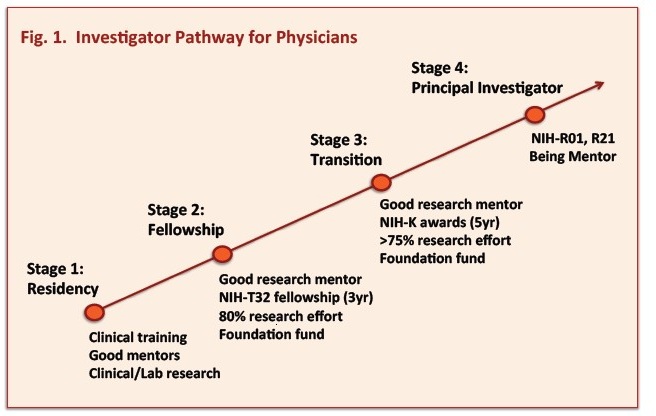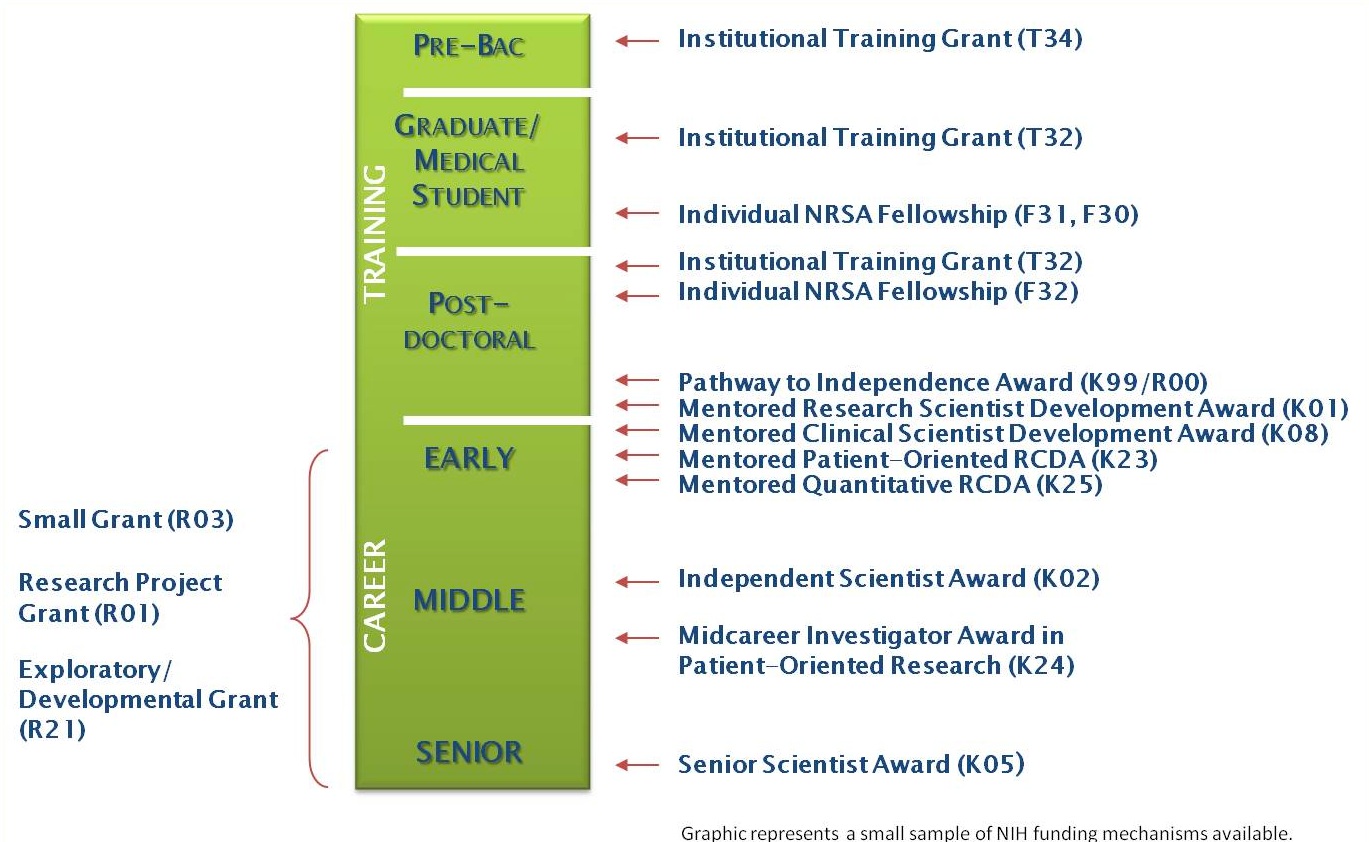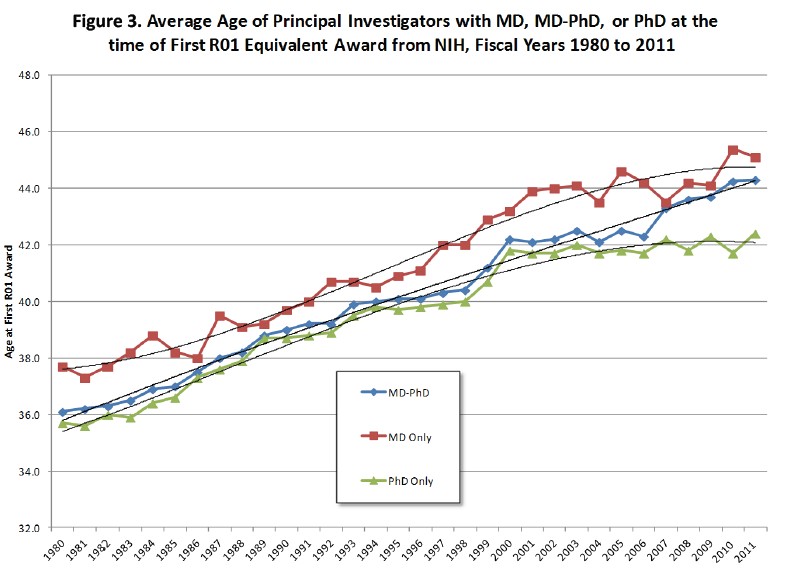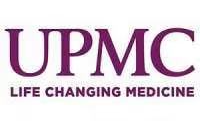INVESTIGATOR PATHWAYS FOR ACADEMIC PHYSICIAN

Wei Chao 巢卫, MD, PhD (Class-‐77)
Department of Anesthesia, Critical Care and Pain Medicine
Massachusetts General Hospital
Harvard Medical School
Boston, MA
After years of hard work, you passed the USMLE exam, were matched to a good residency program and finally completed your clinical training. You would inevitably have to make one of the most important decisions in your professional career: to choose between academic medicine and private practice. In the U.S., an overwhelming majority of MDs go to private practice after their clinical training. They take care of patients in offices and in community hospitals. They are an essential part of the U.S healthcare delivering system. In most cases, they do not have teaching or research responsibilities.
A small number of physicians choose to work in medical school-‐affiliated hospitals, where they carry out 3 core missions of major teaching hospitals, patient care, teaching, and innovative research.
This article outlines the research career pathways for academic physicians. Of note, these pathways are mainly for MDs conducting basic science research. Physicians pursuing clinical research may have different pathways in terms of their funding sources and necessary courses they may need to fulfill. For clinical research, industry and private foundation funding play a major role although the National Institutes of Health (NIH) has increasingly committed to translational and even clinical research. The topic of clinical research pathways will be covered in a separate article.
As illustrated in Fig. 1, the physician investigator pathway could be divided into 4 stages: 1) Residency, 2) Post-‐residency research fellowship, 3) Transition to independence, and 4) Independent Principal Investigator.

Stage 1: Residency
Without doubt, the most important goal of any resident training is to obtain sufficient clinical skills that are essential for you to become a competent physician. Having solid medical knowledge and proficient clinical skills is the foundation and pre-‐condition for anyone who wants to pursue future research career as a physician. Considering how much you have been invested in medical school and then clinical training, you should become a competent doctor first and then a researcher.
1. Stay connected
Having said that, it is important to stay connected with research during your residency if you do consider a research career after the clinical training. Many top residency programs in the U.S. have various research/career-‐related components built in their residency curriculum, such as 1) Research mentorship, 2) Career advice and development, 3) Lecture series on faculty research. It is important to discuss with your program director about your career plan and to have his or her advice and support.
2. Good mentorship
Having a good mentor is extremely important for your career development. Mentor acts as your advocate who is genuinely interested in promoting your career. To identify a good mentor, you need to talk to people around, in your department, hospital, and medical school, and do some search on your faculty members. Regardless what stage your career may be, you need a mentor(s) (1, 2). Given the nature of the career pathway (i.e., research), you need to have a mentor who is a well-‐established and NIH R01-‐funded investigator and who shares similar research interests with you. It would be preferable that the mentor is a MD and has had prior mentoring experience with MD researchers, but that is not absolute.
3. Consider research block
Many specialty programs such as anesthesiology and surgery offer a block of protected research time to residents. For example, American Board of Anesthesiologists (ABA) offers residency credit to residents who pursue 6 months of full-‐time research during the CA (Clinical Anesthesia)-‐3 year. While it is debatable as to what advantage the research block during the residency may offer, it clearly gives one an early start to generate preliminary data that may be critical for your post-‐ residency research fellowship applications.
Stage 2: Post-‐residency Fellowship
This is a critical and also most vulnerable period as many MD researchers “drop out” during this period for a variety of reasons. You are now an attending physician practicing medicine part-‐time and at the same time, trying to establish your own research capability as a fellow in your mentor’s lab. If your department has a strong academic track record, most likely there is a NIH-‐sponsored Institutional Training Grant (T32) in place (Fig. 2) (http://grants.nih.gov/grants/guide/pa-files/PA-06-468.html). In that case, you just need to apply for the T32 fellowship within department and don’t have to deal with NIH.
The T32 training program mandates at least 80% of research effort from awarded trainees. This period is critical as the T32 fellowship provides necessary funding for your protected research time. However, it only provides 3 years of support. You have to make a good progress within the 3 years in order to move on to the next stage. Again, it is important to have a good mentor who understands you (being a part-‐time physician and researcher) and the issues specifically associated with physicians, such as absence from the lab on your post-‐call days and your clinical responsibilities at hospital. The post-‐residency research training is intense and you have to work hard and be productive.
In our department, T32 awardees’ salary is supported by the combination of clinical service, the T32 fellowship, and the departmental fund. If your department does not have T32 in place, the department would need to use departmental fund to support you. In any case, it is extremely important to have some protected research time to pursue your research career, and that, of course, costs money. Your departmental support is the key. Without the support from your mentor(s) and chief, you will have a hard time to succeed. That is one of the most common causes for the “drop-‐ out”. This is the period when you are most vulnerable.

Fig. 2. NIH offers different funding mechanisms to researchers at different stages and different career pathways. For MD or MD/PhD researchers, T32, K08, K23 are very popular. To PhD researchers, F32, K01, and K99/00 are popular. K99/00 is also available to MD researchers.
Stage 3: Transition To Independence
In most cases, the three-‐years of T32 fellowship training isn’t sufficient to lead you to become an independent investigator. Additional research pursuit is often needed to make the transition to independence. There are a few foundations and NIH funding mechanisms that are specifically designed to support such transition, such as Career Development awards from NIH, the New Investigator Award from American Society of Anesthesiologists, or Career Development Award from American Heart Association, to name a few.
Of all, the most popular one among junior physicians is NIH’s “Mentored Clinical Scientist Research Career Development Awards” (http://grants1.nih.gov/grants/guide/pa-files/PA-11-193.html) or commonly known as K08 award. A K08 equivalent for clinical investigator is K23 or “Mentored Patient-‐Oriented Research Career Development Award” (Fig. 2). Table I compares three different career development awards. K08 award provides up to $100,000 in salary support plus fringe benefits per year to MD or MD/PhD investigator for up to five years. PhD researchers are not eligible for K08, but can apply for K01. In addition, it provides up to $30,000 of research support. In return, the K08 award mandates at least 75% professional effort to conducting research.
K08 is important in two ways: 1) It provides the “protected time” so you can intensely focus on your research project with a very limited clinical responsibility, and 2) It provides an opportunity for you to further strengthen your research capability and to develop you own independent project(s), the two key elements for you to make a successful transition from a mentored physician-‐scientist to an independent investigator.
K99/R00 award is designed to help senior postdoc to make a smooth transition to independence and is popular among PhD researchers. It provides $75,000 of annual salary support for the first two years. Pending the working progress (e.g., new papers and a faculty job offer), the awardee will get $250,000/year of research support for the latter 3 years as an independent investigator.
In addition to developing an innovative research project, another important goal during this transition period is to develop a grant-‐writing skill. While many researchers have had vigorous research training during medical or graduate school, very few have been taught grant writing. Writing a winning grant proposal is a necessary skill for any successful principal investigators. Learn the skills from your mentors, your advisors, your collaborators, and in workshops. This is a big topic that is beyond the scope of this article. I have included two papers on the topics of research funding and grant writing for your reference (3, 4).
Table 1. Comparison of three career development (K) awards
|
NIH Program |
K08 |
K23 |
K99/R00 |
|
Title |
Mentored Clinical Scientist Research Career Development Award |
Mentored Patient- Oriented Research Career Development Award |
NIH Pathway to Independence Award |
|
For Whom |
Clinical doctoral degrees (MD, DO, DMD, PharmD, DVM…) |
Clinical doctoral degrees (MD, DO, DMD, PharmD, DVM…) |
Clinical/Research doctorate (MD or PhD) |
|
% Effort |
75% |
75% |
|
|
Duration |
3-5 y |
3-5 y |
2 y (K99) + 3 y (R00) |
|
$$$ per year (NHLBI) |
$75K salary+fringe |
$75K salary+fringe |
K99: $75K+fringe |
|
Deadline (NHLBI) |
Feb 12, June 12, Oct 12 |
Feb12, June12, Oct12 |
Feb12, June12, Oct12 |
NHLBI: National Heart, Lung, and Blood Institute. Other NIH institutes offers similar awards with some minor differences.
Stage 4: Principal Investigator
To become an independent researcher or principal investigator (PI), you need to have an adequate level of funding to support your projects. This is true for both basic and clinical investigators. For a basic researcher, that means you’ll need to obtain your own independent funding, most like from NIH. The most common funding mechanism for most PIs is the Research Project Grant or better known as R01 (Fig. 2) (http://grants.nih.gov/grants/guide/pa-files/PA-10-067.html).
The increasing complexity of science and thus demand on our scientific knowledge and skills has resulted in a steady increase, between 1980-‐2010, in the new investigator’s age at which they obtain their first R01s. As illustrated in Fig. 3, the average age of new PhD R01 investigators increased from 36 in 1980 to 42 in 2010. This number is even higher for researchers with a MD or a MD/PhD.

The good news is that NIH realizes the enormous challenge of such transition and has thus designed a set of policies to encourage and promote new investigator’s first R01 application (http://grants.nih.gov/grants/new_investigators/#earlystage).
R01 award provides a large sum of dollars ($250,000 or more of direct cost per year) for up to five years. With this grant and hopefully the support from your department in the form of start-‐up fund, you will finally be able to have your own laboratory and enjoy your independent and innovative research.
Some Perspectives
Challenges —— The pathway to be an independent investigator as a physician is long and challenging. The average time from the completion of residency to the first R01 award is approximately eight years assuming that everything goes smoothly. Given the economic downturn during the past 5-‐10 years, the NIH budget has been declining. The paylines for most NIH institutes/centers are around 10%. The situation is challenging for all researchers but even more so for physicians as many of us have to devote at least 20-‐40% efforts to patient care and resident teaching. Despite of the challenges, many academic physicians enjoy their careers in teaching hospitals as clinicians, teachers, and researchers.
Opportunities ——The ultimate goal of research is to improve human health. There are advantages as well as opportunities for academic physicians. Physicians have the first hand of knowledge about human diseases. We take care of patients, identify underlying clinical issues and challenges, ask critical questions, form hypotheses, and then test the hypotheses in well-‐controlled experimental settings. In doing so, we advance our knowledge of human diseases, translate the knowledge to novel treatments, and ultimately, improve the patients’ outcome.
A personal note, as anesthesiologists, we take care of many critically sick patients who suffer from ischemic myocardial infarction, severe surgical infection, septic shock due to infection or trauma. Both ischemic myocardial infarction and septic shock carry a very high morbidity and mortality. Over the years, my colleagues and I (and many other academic physicians at Mass General Hospital) have been making tremendous efforts investigating the two critical clinical conditions. The process of creating new knowledge about these critical illnesses and searching for new treatment is truly rewarding.
References
- Lee, A., Dennis, C., and Campbell, P. 2007. Nature's guide for mentors. Nature 447:791-‐797.
- Bettmann, M. 2009. Choosing a research project and a research mentor. Circulation 119:1832-‐1835.
- Sumandea, C.A., and Balke, C.W. 2009. Funding opportunities for investigators in the early stages of career development. Circulation 119:1320-‐1327.
- Yang, O., and Miller, P. 2009. Straight talk with ... Otto Yang and Patrick Miller. Interviewed by Kirsten Dorans. Nature medicine 15:592-‐593.






